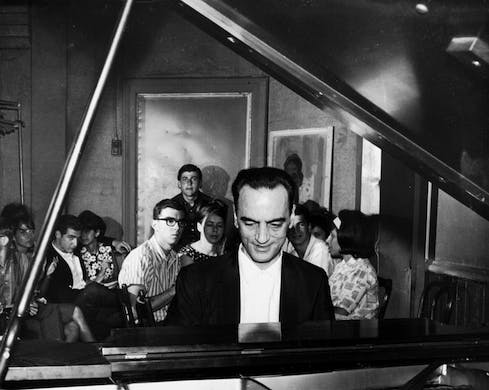Jazz Titan Tristano’s Slim Recorded Output Finally Grows
Many know Lennie Tristano through the profound effect his work had on such subsequent piano giants as Bill Evans and Dave Brubeck.

“Lennie Tristano Personal Recordings 1946-1970”
(Mosaic Records / Dot Time MD6-272)
The legendary singer Bing Crosby, with characteristically extravagant eloquence, once referred to Dixieland jazz fans as a “cult.” He was being at least slightly ironic: Traditional and New Orleans-style jazz was hugely popular at the time he employed the phrase.
If there’s any specific subgenre of jazz that always suggested a cult to me, though — at least from the outside looking in — it’s that area of the music that gathered around the remarkable pianist, composer, bandleader, educator, and genuine iconoclast Lennie Tristano (1919-1978).
I have no memory of hearing Tristano live — there remains a likelihood that my father carted me along to one of his performances at a point when I was too young to remember — but I do know that Tristano-ites were all over the jazz scene in the 1970s and ’80s, both in terms of musicians and fans.
His influence is still very much out there, including among contemporary musicians who picked up on Tristano directly, like the fine and highly interesting pianist Virg Dzurinko and the saxophonist Mark Turner, who knows well the work of Tristano collaborator Warne Marsh.
There are also legions more who know Tristano through the profound effect he had on such subsequent piano giants as Bill Evans and Dave Brubeck.
Further, although Tristano essentially stopped performing by the age of 50, his most celebrated collaborator, alto saxophonist Lee Konitz, kept playing without a letup from the mid-1940s right up to the pandemic era, until his death at 92 in 2020. (It should be noted that both Tristano and Konitz would bristle at the latter being described, as he often was, as a Tristano “acolyte.”)
For a titan of his caliber, Tristano’s recorded output is egregiously small, which is why the release of six CDs filled with previously unheard private recordings is a major event. The set owes its existence to the Tristano family; to Jerry Roche of Dot-Time Records, who has already released several collections of Tristano music; and to musicians such as guitarist Billy Bauer, who saved the music — on acetates, tape, and the short-lived technology of wire recording.
A particularly essential contribution was made by saxophonist and longtime Tristano sideman Lenny Popkin, who serves both as audio restoration engineer and annotator — and defender of the Tristano faith.
In his function as annotator, Mr. Popkin informs us that most of the received wisdom concerning Tristano is flat-out wrong. Perhaps it’s because Tristano was one of the founding fathers of jazz education — among the first to demonstrate that improvisation could be taught — that his music is often described as cool, intellectual, and even academic. One of the most rewarding aspects of the many live performances in this package is how warm and even fiery Tristano’s various duos, trios, quartets, quintets, and sextets are.
There’s some especially inspired playing from The Orchid Room on Swing Street (West 52nd Street, where they shared the bill with a young Harry Belafonte) in 1950. Here, the six players — particularly the two saxophonists, Konitz (alto) and Marsh (tenor) — achieve a level of synergy that’s remarkable, even for them. The “tutti” moments, following the individual solos, wherein the four rhythm and two reeds all come together, are both breathtaking and exhilarating, especially on the 10-minute “Sound-Lee.”
The earliest material in the package, a set of trio sessions from various venues around New York from 1946 and ’47 — possibly the first known recordings of a Tristano ensemble — are also exciting, even thrilling. The combination of piano, guitar (Billy Bauer), and bass (Arnold Fishkin) suggests that Tristano had, at some level at least, been listening to the King Cole Trio; the block chord passages on “Rhapsody” are particularly reflective of Cole’s influence. Like much of the set, the music is variations on standards, with hints as to the source material in both the titles and the melodies.
The best-recorded music here is a series of completely solo performances taped in a studio rather than a club; the extra fidelity is appreciated because Tristano sounds like a four-handed piano duet even when he’s playing by himself. “Lennie’s Blues” and “Dusk” are dark and mysterious, but he’s delightfully straightforward on “These Foolish Things.”
The set ends with 42 minutes of live performances from The Half Note in the West Village, 1962, mostly in a duo format with bassist Sonny Dallas. The finale is a 10-minute “How Deep is the Ocean,” in which the two are joined by Konitz and, in his only known appearance with Tristano, tenor sax giant Zoot Sims.
It’s typical of Tristano’s acumen that the climax is not the fastest or most exciting piece in the set, but the most personal and romantic. If there’s anything cold or academic about the music of Lennie Tristano, you won’t find it here.

